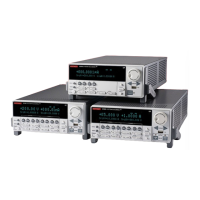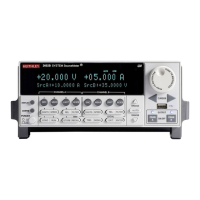Series 2600 System SourceMeters Reference Manual Instrument Control Library 12-83
Return to Section 12 topics 2600S-901-01 Rev. A / May 2006
Example Read the number of readings stored in SMU A buffer 1:
bufferreadings = smua.nvbuffer1.n
print(bufferreadings)
Output: 1.250000+02
The above output indicates that there are 125 readings stored in the buffer.
smuX.nvbufferY.timestampresolution
X = SMU channel (a or b)
Y = NV buffer (1 or 2)
Attribute Timestamp resolution.
Usage
tsres = smuX.nvbufferY.timestampresolution -- Reads collection state.
smuX.nvbufferY.timestampresolution = tsres -- Writes collection state.
tsres Timestamp resolution in seconds.
Remarks
• Assigning to this attribute sets the resolution for the timestamps. Reading this
attribute returns the timestamp resolution value.
• The minimum timestamp resolution is 0.000001seconds (1µs). At this resolution, the
reading buffer can store unique timestamps for up to 71 minutes. This value can be
increased for very long tests.
• When setting this value it will be rounded to an even power of 2µs.
Details See “Reading buffers” in this section and in Section 7.
Also see smuX.measure.overlappedY, smuX.measure.Y, smuX.nvbufferY
Example Set the timestamp resolution for SMU A buffer 1 to 10µs:
smua.nvbuffer1.timestampresolution = 0.00001
smuX.reset
X = SMU channel (a or b)
Function Turns off the output and resets the SMU to the default settings.
Usage
smuX.reset()
Remarks Returns the SMU to the default settings listed in Table 1-3.
Details See “Default settings” in Section 1.
Also see reset

